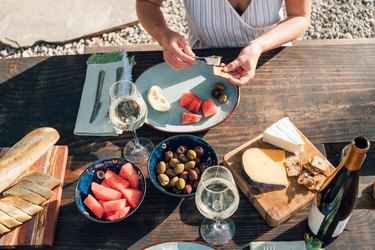
You may love a stinky, moldy Camembert as much as the next person but find that you have no love for that multicolored fuzz that pops up on your block of sharp cheddar. Toss it, keep it, cut off the fur — what do you do?
Read more: Healthy Cheese? Yep! Here Are the 10 Best Options
Video of the Day
Video of the Day
Is Moldy Cheese Safe to Eat?
Fast forward to the real concern: Is moldy cheese actually safe to eat and how do you make that decision? It usually is safe to eat moldy cheese — but there's a caveat. It really depends on the type of cheese and your individual health.
There are certain molds that are used to make cheeses, like Roquefort, bleu cheese, Brie, Camembert and Gorgonzola. These particular cheeses are perfectly safe to eat, since the mold was an intentional part of the manufacturing process.
These cheeses are created with P. roqueforti or Penicillium roqueforti spores as intentional ingredients and left to further mature, according to the USDA. There are, however, populations that should avoid these cheeses including anyone with an immune-compromised system as well as pregnant women, young children and the elderly.
Avoid These Types of Cheese if They Grow Moldy
Soft cheeses such as cottage cheese, cream cheese, feta and ricotta should under no circumstance be eaten if mold is present. And don't try cutting the moldy pieces off! These softer cheese varieties have a higher moisture content, which allows the insidious mold to hide beyond what we can see. So, your best bet would be to throw out the entire block.
Bacteria such as listeria, brucella, salmonella and E. coli also thrive in moist environments. Eating or consuming bacteria like E. coli can have a detrimental effect on one's health and may result in an unwanted bacterial infection.
However, if you find mold on any harder cheeses like cheddar or parmesan, you can simply cut it out and consume the rest of the block. Hard cheeses have a lower moisture content, which helps prevent the mold from spreading like it does in soft cheeses.
Tip
A good rule of thumb is to cut the mold plus an inch off. And make sure to keep the knife away from the mold so that it doesn't cross-contaminate the unaffected parts of the cheese, the USDA recommends.
And at the end of the day, the old food safety saying holds true, "When in doubt throw it out."
Read more: The Effects of Eating Cheese Late at Night
Was this article helpful?
150 Characters Max
0/150
Thank you for sharing!
Thank you for your feedback!